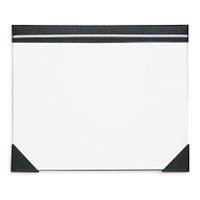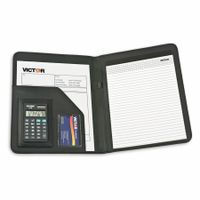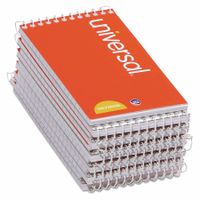Call +(254) 703 030 000 / 751 483 999 / 721 704 777
- Home
- Office Supplies
- Office Paper Notebooks
- Notebooks Notepads
.....Read More
Frequently Asked Questions
What is the difference between wirebound and nonwirebound notebooks?
Wirebound notebooks have pages held together by a spiral wire or coil, allowing them to lay flat when open and fold back on themselves for easy writing. They often have perforated pages for easy removal and are typically more durable due to the metal binding. However, the wire can get bent or snag on items, and the notebook may be bulkier.
Nonwirebound notebooks, such as perfect-bound or stitched, have pages glued or sewn into the spine. They offer a sleeker appearance and are less likely to snag on items. These notebooks may not lay completely flat, making writing near the spine more challenging. They are often more compact and professional-looking but may not be as durable as wirebound options.
What are the benefits of using all-weather notebooks?
All-weather notebooks offer several benefits, making them ideal for various environments and professions.
1. **Water Resistance**: These notebooks are designed to withstand rain, sweat, and humidity. The pages are often made from a special type of paper that repels water, ensuring that notes remain legible even in wet conditions.
2. **Durability**: Constructed with robust materials, all-weather notebooks are resistant to tearing and wear, making them suitable for outdoor use and harsh environments.
3. **Versatility**: They are useful for a wide range of activities, including hiking, field research, military operations, and construction work. Their ability to perform in diverse weather conditions makes them a reliable tool for professionals and enthusiasts alike.
4. **Enhanced Writing Experience**: The paper in all-weather notebooks is often designed to work with various writing instruments, including pencils, pens, and markers, without smudging or bleeding.
5. **Portability**: Typically compact and lightweight, these notebooks are easy to carry, fitting conveniently into pockets or bags, which is essential for on-the-go note-taking.
6. **Longevity**: Notes taken in all-weather notebooks are preserved over time, as the paper resists degradation from environmental factors, ensuring that important information is not lost.
7. **Eco-Friendly Options**: Many all-weather notebooks are made from recycled materials or are recyclable themselves, appealing to environmentally conscious users.
8. **Professional Appearance**: Despite their ruggedness, these notebooks often maintain a professional look, suitable for business or academic settings.
Overall, all-weather notebooks provide a reliable and durable solution for note-taking in any condition, ensuring that important information is captured and preserved regardless of the environment.
How do lab notebooks differ from regular notebooks?
Lab notebooks differ from regular notebooks in several key ways, primarily due to their specific purpose and the requirements of scientific documentation:
1. **Purpose and Use**: Lab notebooks are used to document experiments, observations, and results in a scientific setting. They serve as a legal record of research and are crucial for patent applications, publications, and reproducing experiments. Regular notebooks are used for general note-taking, personal use, or educational purposes without the need for formal documentation.
2. **Structure and Format**: Lab notebooks often have a structured format to ensure consistency and completeness. They may include sections for the date, objective, materials, methods, results, and conclusions. Regular notebooks do not follow a specific structure and are more flexible in their use.
3. **Permanence and Security**: Entries in lab notebooks are typically made in permanent ink to prevent tampering or accidental erasure. They may also be bound to prevent the removal or addition of pages. Regular notebooks can be spiral-bound or loose-leaf and are often written in pencil or erasable ink.
4. **Legal and Ethical Considerations**: Lab notebooks are often subject to legal scrutiny and must adhere to ethical standards. They are used to establish the timeline of discoveries and can be critical in intellectual property disputes. Regular notebooks do not have such legal implications.
5. **Content Detail**: Lab notebooks require detailed and precise documentation of procedures, data, and observations to ensure that experiments can be replicated. Regular notebooks may contain summaries or personal reflections without the need for exhaustive detail.
6. **Review and Witnessing**: Lab notebooks may require regular review and witnessing by a colleague or supervisor to verify the authenticity and accuracy of the recorded data. Regular notebooks do not require such oversight.
These differences highlight the specialized nature of lab notebooks in scientific research compared to the general-purpose use of regular notebooks.
What types of paper are available in notebooks and notepads?
Notebooks and notepads come with various types of paper, each serving different purposes and preferences:
1. **Ruled Paper**: This is the most common type, featuring horizontal lines to guide handwriting. Variations include wide-ruled, college-ruled, and narrow-ruled, differing in line spacing.
2. **Plain/Blank Paper**: Lacks any lines or grids, ideal for sketching, drawing, or freeform note-taking.
3. **Grid/Graph Paper**: Contains a grid of squares, useful for mathematical calculations, technical drawings, and graphs. The grid size can vary, with common options being 4x4 or 5x5 squares per inch.
4. **Dot Grid Paper**: Features dots at regular intervals, offering a subtle guide for writing or drawing without the constraints of lines or grids. Popular in bullet journaling.
5. **Perforated Paper**: Designed for easy removal from the notebook, often used in notepads for tear-off notes or lists.
6. **Recycled Paper**: Made from recycled materials, appealing to environmentally conscious users. It may have a slightly different texture or color.
7. **Colored Paper**: Available in various colors, used for organizing notes or adding visual interest.
8. **Waterproof/Tear-resistant Paper**: Made from synthetic materials, suitable for outdoor use or in environments where paper might get wet.
9. **Acid-free Paper**: Resists yellowing and deterioration over time, ideal for archival purposes or long-term note storage.
10. **Specialty Paper**: Includes options like music manuscript paper, calligraphy paper, or paper with pre-printed templates for specific uses.
These paper types cater to diverse needs, from academic and professional to artistic and personal, allowing users to choose based on their specific requirements.
How can I prevent my notebook from snagging on clothes?
To prevent your notebook from snagging on clothes, consider the following strategies:
1. **Smooth Edges**: Ensure that the edges of your notebook are smooth. If the notebook has a spiral binding, check for any sharp or protruding wire ends. Use pliers to gently bend or tuck in any sharp points.
2. **Cover the Spiral**: Use a fabric or plastic cover to encase the spiral binding. This can be a DIY project using materials like felt or a purchased spiral cover designed to fit over the binding.
3. **Choose the Right Material**: Opt for notebooks with bindings that are less likely to snag, such as those with plastic spirals or perfect binding (glued spine).
4. **Protective Sleeve**: Store your notebook in a protective sleeve or pouch when not in use. This not only prevents snagging but also protects the notebook from other types of damage.
5. **Mindful Handling**: Be cautious when placing or removing the notebook from bags or when carrying it near delicate fabrics. Hold it by the spine or cover rather than the edges.
6. **Regular Maintenance**: Periodically check your notebook for any wear and tear. Address any issues immediately to prevent them from worsening.
7. **Alternative Binding**: Consider using notebooks with alternative binding methods, such as disc-bound or stitched notebooks, which are less likely to have snagging issues.
8. **Custom Modifications**: If you're handy, you can modify the notebook by adding a layer of tape or fabric over the binding to smooth out any rough areas.
By implementing these strategies, you can significantly reduce the risk of your notebook snagging on clothes.
What are the advantages of using graph paper in notebooks?
Graph paper in notebooks offers several advantages:
1. **Precision and Neatness**: The grid layout of graph paper helps maintain precision and neatness in writing, drawing, and calculations. It provides a structured guide that ensures uniformity in letter size and spacing, which is particularly beneficial for those with handwriting that tends to be uneven.
2. **Mathematical and Scientific Applications**: Graph paper is ideal for plotting graphs, drawing geometric shapes, and solving mathematical problems. It aids in accurately representing data and functions, making it a valuable tool for students and professionals in mathematics, engineering, and sciences.
3. **Design and Art**: Artists and designers use graph paper for creating detailed sketches, patterns, and layouts. The grid helps in maintaining proportions and symmetry, which is crucial in design work.
4. **Organizational Aid**: The structured format of graph paper assists in organizing information systematically. It is useful for creating tables, charts, and diagrams, facilitating better data visualization and comprehension.
5. **Versatility**: Graph paper can be used for a variety of purposes beyond mathematics and art, such as bullet journaling, where it helps in creating organized and aesthetically pleasing layouts for planners and trackers.
6. **Enhanced Learning**: For students, graph paper can improve learning by providing a clear framework for problem-solving and note-taking. It encourages logical thinking and helps in visualizing complex concepts.
7. **Technical Drawings**: Engineers and architects often use graph paper for technical drawings and blueprints. The grid ensures accuracy and scale, which are critical in technical fields.
Overall, graph paper enhances precision, organization, and creativity, making it a versatile tool for various academic, professional, and personal applications.
Are there notebooks specifically designed for construction sites?
Yes, there are notebooks specifically designed for construction sites. These notebooks are tailored to withstand the harsh conditions typically found on construction sites, such as dust, moisture, and rough handling. They often feature durable covers made from materials like waterproof or tear-resistant paper, and some may have reinforced bindings to prevent pages from falling out. The pages themselves are usually made from water-resistant paper, allowing notes to be taken in wet conditions without smudging or tearing.
Additionally, these notebooks may include features that cater to the specific needs of construction professionals. For instance, they might have grid or graph paper for sketching plans and layouts, pre-printed templates for project management, or conversion charts for quick reference. Some notebooks also come with pockets for storing loose documents or business cards.
In terms of size, construction site notebooks are often compact and portable, making them easy to carry around the site. They may also have features like elastic closures or pen holders to keep everything secure and accessible.
Overall, these specialized notebooks are designed to be practical and resilient, ensuring that construction professionals can reliably record and access important information on-site, regardless of the environmental challenges they might face.




